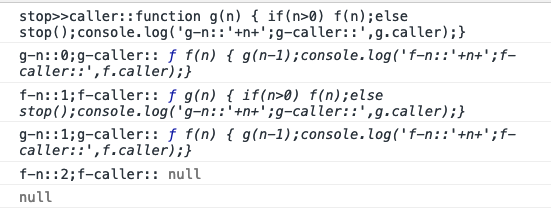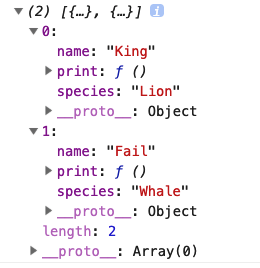# 全面认识Function
Function构造函数创建一个新的Function对象。在JavaScript中,每个函数实际上都是一个Function对象。
new Function([arg1[,arg2[,...argN]],]functionBody);
// 参数
arg1,arg2,...argN // 被函数使用的参数的名称必须是合法命名的。参数名称是一个有效的JavaScript标识符的字符串,或者一个用逗号分隔的有效字符串的列表。
functionBody // 一个含有包括函数定义的JavaScript语句的字符串。
使用Function构造器生成的Function对象是在函数创建时解析的。这比使用函数声明或者函数表达式并在代码中调用更为低效,因为使用后者创建的函数是跟其他代码一起解析的。
以调用函数的方式调用Function的构造函数(不是用new关键字)跟以构造函数来调用时一样的。
全局的Function对象没有自己的属性和方法,但是,因为它本身也是函数,所以它也会通过原型链从Function.prototype上继承部分属性和方法。
WARNING
注:使用Function构造器生成的函数,并不会在创建它们的上下文中创建闭包;它们一般在全局作用域中被创建。当运行这些函数的时候,它们只能访问自己的本地变量和全局变量,不能访问Function构造器被调用生成的上下文的作用域。
# 属性
# prototype
该属性存储了Function的原型对象。
Function对象(函数实例)继承自Function.prototype属性。因此Function.prototype不能被修改。
# name
该属性返回函数实例的名称
name的属性特性:writable:false;enumerable:false;configurable:true
示例:
// 使用new Function(...)语法创建的函数
console.log((new Function).name); // anonymous
// 变量和方法可以从语法位置推断匿名函数的名称
let f = function(){};
let c_f=f;
let object = {
someMethod:function(){}
};
console.log(f.name); // f
console.log(c_f.name); // f,定义时的变量名决定了方法名
console.log(object.someMethod.name); // someMethod
// 在函数表达式中定义函数的名称
let fn = function fn_method(){};
console.log(fn.name); // fn_method
// fn_method只是一个方法名,放在fn这个对象里,它不是一个变量
try {
console.log(fn_method);
} catch(err) {
console.log(err); // Uncaught ReferenceError: fn_method is not defined
}
// 简写方法的名称
let o = {
foo(){}
}
console.log(o.foo.name); // foo
// 绑定函数的名称
function foo(){};
console.log(foo.bind({}).name); // bound foo
// getter和setter的函数名
let fn_obj = {
get foo(){},
set foo(x){}
}
let descriptor = Object.getOwnPropertyDescriptor(fn_obj, 'foo');
console.log(descriptor.get.name); // get foo
console.log(descriptor.set.name); // set foo
// Symbol作为函数名称
let sym1 = Symbol('foo');
let sym2 = Symbol();
let sym_o = {
[sym1]: function(){},
[sym2]: function(){}
}
console.log(sym_o[sym1].name); // [foo]
console.log(sym_o[sym2].name); // ' '
# length
该属性指明函数的形参个数。
属性的属性特性:writable:false;enumerable:false;configurable:true;
length是函数对象的一个属性值,指该函数有多少个必须要传入的参数,即形参的个数。
形参的数量不包括剩余参数的个数,仅包括第一个具有默认值之前的参数个数。
# caller
该属性返回调用指定函数的函数。
如果一个函数f是在全局作用域内被调用的,则f.caller为null,相反,如果一个函数是在另一个函数作用域内被调用的,则f.caller指向调用它的那个函数。
示例:递归
function f(n) { g(n-1); console.log('f-n::' + n +'; f-caller::', f.caller);};
function g(n) { if(n>0) f(n); else stop(); console.log('g-n::' + n + '; g-caller::', g.caller);};
function stop() { console.log('stop>>caller::' + stop.caller)};
f(2);
// f(2)->g(1)->f(1)->g(0)->stop();

结果:可以看到stop里只打印了最后一个调用它的方法,注意打印的与调用顺序相反,因为把打印放在了调用后面
# 原型方法
没有自身的方法,只有原型方法,即在prototype上的方法
# apply
调用一个具有给定this值的函数,以及作为一个数组(或类数组对象)提供的参数。
func.apply(thisArg, [argsArray]);
// 参数
thisArg // 可选,在func函数运行时使用的this值。注意:this可能不是该方法看到的实际值:如果这个函数处于非严格模式下,则指定为null或undefined时会自动替换为指向全局对象,原始值会被包装。
argsArray // 可选,一个数组或者类数组对象,其中的数组元素将作为单独的参数传给func函数。如果该参数值为null或undefined,则表示不需要传入任何参数。
// 返回值:调用有指定this值和参数的函数的结果
可以使用arguments对象作为argsArray参数,arguments是一个函数的局部变量,它可以被用做被调用对象的所有未指定的参数。这样,在使用apply函数的时候就不需要知道被调用对象的所有参数。可以使用arguments来把所有的参数传递给被调用对象。
示例:
let arr1 = [1, 2];
let arr2 = [3, 4, 5];
let arr_c = arr1.concat(arr2);
console.log(arr_c); // [1, 2, 3, 4, 5]
console.log(arr1); // [1, 2]
console.log(arr2); // [3, 4, 5]
let arr_p = [].push.apply(arr1, arr2);
console.log(arr_p); // 5
console.log(arr1); // [1, 2, 3, 4, 5]
console.log(arr2); // [3, 4, 5]
let num = [3, 5, 672, 12, 3, 1];
console.log(Math.max.apply(null, num)); // 672,基本等同于Math.max(num[1],...)
console.log(Math.min.apply(null, num)); // 1
WARNING
如果用上面的方式调用apply,会有超出JavaScript引擎的参数长度限制的风险。当对一个方法传入非常多的参数时,就非常有可能会导致越界问题,这个临界值是根据不同的JavaScript引擎而定的。
# call
调用一个函数,其具有一个指定的this值和分别地提供的参数。
fun.call(thisArg, arg1, arg2, ...);
// 参数
thisArg // 参考上面apply的thisArg
arg1, arg2, ...; // 指定的参数列表
// 返回值:使用调用者提供的this值和参数调用该函数的返回值。若该方法没有返回值,则返回undefined。
示例:匿名函数使用call
let animals = [
{species: 'Lion', name: 'King'},
{species: 'Whale',name: 'Fail'},
];
for(let i = 0; i < animals.length; i++){
(function(i){
this.print = function(){
console.log('#' + i + ' ' + this.species + ': ' + this.name);
}
}).call(animals[i], i);
}
console.log(animals);

WARNING
如果没有传递第一个参数,this的值将会被绑定为全局对象。在严格模式下this的值将会是undefined。
# bind
创建一个新的函数,在调用时设置this关键字为提供的值。在调用新函数时,将给定参数列表作为原函数的参数序列的前若干项。
function.bind(thisArg[, arg1[, arg2[, ...]]]);
// 参数
thisArg // 参考Apply的参数,这里必填
arg1,arg2,...; // 当目标函数被调用时,预先添加到绑定函数的参数列表中的参数。
// 返回值:一个原函数的拷贝,并拥有指定的this值和初始参数
bind()函数会创建一个新绑定函数(bound function,BF)。绑定函数是一个exotic function object(怪异函数对象),它包装了原函数对象。调用绑定函数通常会导致执行包装函数。
绑定函数具有以下内部属性:
- [[BoundTargetFunction]] - 包装的函数对象。
- [[BoundThis]] - 在调用包装函数时始终作为this值传递的值。
- [[BoundArguments]] - 列表,在对包函数做任何调用都会优先用列表元素填充参数列表。
- [[Call]] - 执行与此对象关联的代码。通过函数调用表达式调用。内部方法的参数是一个this值和一个包含通过调用表达式传递给函数的参数的列表。
当调用绑定函数时,它调用[[BoundTargetFunction]]上的内部方法[[Call]],就像Call(boundThis,arg)。其中boundThis是[[BoundThis]],args是[[BoundArguments]]加上通过函数调用传入的参数列表。
绑定函数也可以使用new运算符构造,它会表现为目标函数已经被构建完毕了似的。提供的this值会被忽略,但前置参数仍会提供给模拟函数。
示例:偏函数,bind()使一个函数拥有预设的初始参数。
function list(){
return Array.prototype.slice.call(arguments); // 将类数组对象转换成数组
}
function addArguments(arg1, arg2){
return arg1 + arg2;
}
let list1 = list(1, 2, 3);
console.log(list1); // [1,2,3]
let result1 = addArguments(1, 2);
console.log(result1); // 3
let leadingThirtySevenList = list.bind(null, 37);
let addThirtySeven = addArguments.bind(null, 37);
let list2 = leadingThirtySevenList();
console.log(list2); // [37]
let list3 = leadingThirtySevenList(1, 2, 3);
console.log(list3); // [37, 1, 2, 3]
let result2 = addThirtySeven(5);
console.log(result2); // 42 , 37+5
let result3 = addThirtySeven(5, 10);
console.log(result3); // 42 , 10没有被用到
# toSource
返回函数的源代码的字符串表示。
toSource方法返回下面的值:
- 对于内置的Function对象,
toSource返回下面的字符串:
function Function(){
[native code]
}
- 对于自定义函数来说,toSource返回能定义该函数的JavaScript源码。
# toString
返回一个表示当前函数源代码的字符串。
Function对象覆盖了从Object继承来的toString方法。对于用户定义的Function对象,toString方法返回一个字符串,其中包含用于定义函数的源文本段。
在Function需要转换为字符串时,通常会自动调用函数的toString方法。
若this不是Function对象,则toString()方法将抛出TypeError
# 示例:
| Function | Function.prototype.toString result |
|---|---|
function f(){} | "function f(){}" |
class A { a(){} } | "class A { a(){} }" |
function* g(){} | "function* g(){}" |
a => a | "a => a" |
({ a(){} }.a) | "a(){}" |
({ *a(){} }.a) | "*a(){}" |
({ [0](){} }[0]) | "[0](){}" |
Object.getOwnPropertyDescriptor({get a(){}}, "a").get | "get a(){}" |
Object.getOwnPropertyDescriptor({set a(x){}}, "a").set | "set a(x){}" |
Function.prototype.toString | "function toString() { [native code] }" |
(function f(){}.bind(0)) | "function () { [native code] }" |
Function("a", "b") | "function anonymous(a\n) {\nb\n}" |
← 全面认识Array 全面认识String →